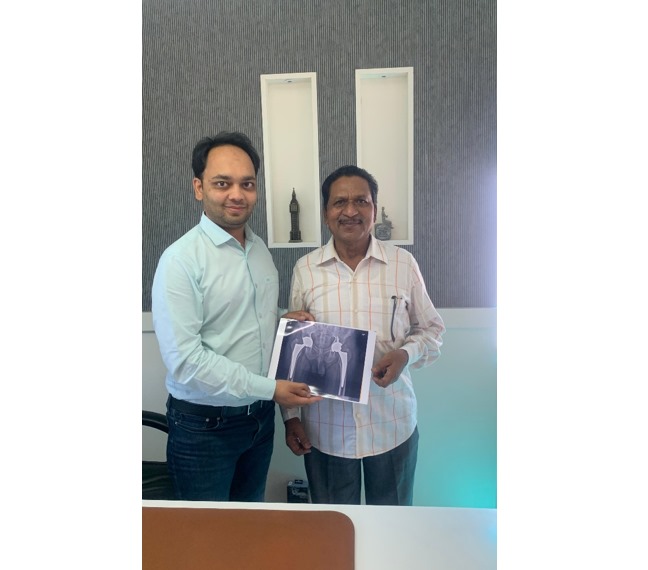Over The past few years, we have experienced a significant rise in hip replacement surgeries especially in younger age groups. Most of the cases have been attributed to post-covid avascular necrosis or AVN.
If we broadly look at treatment and management of AVN, early stages are usually managed by drugs, some injectable, and minor/small regenerative surgeries. While advanced stages require a hip replacement to get rid of pain, deformity and difficulty caused by AVN of Hips.
We also see a lot of patients in whom both the hip are affected.
Hip Replacement in such patients is usually done in a staged fashion: replacement of one hip, follow by 2-4 months, followed by replacement of second hip.
As such the recovery time of the complete process extends to almost a year.
To speed up the process and provide a more convenient solution to this problem of bilateral AVN, our team has been regularly performing and studying results of stage, same sitting, and bilateral hip replacement of the past several years in vast number of patients.
Bilateral same stage hip replacement gives the following advantages:
- Single admission
- Single anaesthesia
- Single stage recovery
- No increase in pain
- Exercises for recovery at one go
- Less Lurch or limp in interval period as both hips are cured
Over the past 5 years we identified patients fit to undergo the both hip replacements and they were thoroughly screened. All patients underwent replacement of both hips using best in class implants, minimally invasive surgery, most modern techniques and under best operative conditions.
We have found no major complication in our patient’s undergoing this surgery through our specialized technique.
We would like to share the story of one such patient we operated very recently.
Mr Kamat , 58 years, was diagnosed with AVN of both hips and was advised hip replacement for both.
He was explained about the prolonged procedure and recovery time extending to almost 1 year.
We were able to shorten this to just a month with our latest techniques for joint replacement surgery, and within a month he is now able to walk pain free, with his new hip joints, does not need any support and is able to get back to his active and independent life.
The smile on patients and their families face is what we achieve at the end of it.
We at Dr Utsav Agrawal’s Varunam Super Speciality Hospital, Nagpur, provide latest high end services for arthritis and joint replacement.
Defining Bilateral Same Sitting Hip Replacement
Bilateral same sitting hip replacement is a surgical procedure where both hip joints are replaced simultaneously during one surgery. This advanced procedure aims to restore mobility, reduce pain, and improve the quality of life for patients suffering from severe hip arthritis or other debilitating hip conditions.
Relevance and Importance
The increasing prevalence of hip disorders, particularly among the elderly, has led to a growing need for effective surgical interventions. Bilateral same sitting hip replacement offers a significant advantage in terms of recovery time, reduced hospital stay, and overall cost-effectiveness, making it a crucial option in modern orthopaedic practice.
Types and Categories
Total Hip Replacement
This involves replacing both the acetabulum (hip socket) and the femoral head (thighbone head) with artificial components. It is the most common type of hip replacement.
Partial Hip Replacement
Also known as hemiarthroplasty, this procedure involves replacing only the femoral head. It is typically performed for certain fractures or less severe hip conditions.
Hip Resurfacing
This involves capping the femoral head with a smooth metal covering and is less invasive than total hip replacement. It is usually recommended for younger, more active patients.
Cemented vs. Uncommented Implants
- Cemented Implants: These are fixed to the bone with a special bone cement.
- Uncommented Implants: These rely on the bone growing into the porous surface of the implant to hold it in place.
Symptoms and Signs
Common Symptoms Indicating Need for Hip Replacement
- Persistent pain in the hip joint, groin, or thigh.
- Stiffness and reduced range of motion.
- Difficulty walking or performing daily activities.
- Swelling and tenderness in the hip area.
Uncommon Symptoms
- Sudden, severe pain indicating possible hip fracture.
- Limb length discrepancy.
- Mechanical symptoms like clicking or catching within the hip joint.
Causes and Risk Factors
Biological Factors
- Osteoarthritis: Wear-and-tear arthritis causing cartilage breakdown.
- Rheumatoid Arthritis: Autoimmune disease leading to joint damage.
- Osteonecrosis: Bone death due to inadequate blood supply.
Environmental Factors
- Physical trauma or injury to the hip.
- Obesity: Excessive body weight putting strain on hip joints.
- Genetic predisposition to hip conditions.
Lifestyle Factors
- Sedentary lifestyle leading to joint deterioration.
- High-impact sports or occupations involving heavy lifting.
- Poor diet lacking essential nutrients for bone health.
Diagnosis and Tests
Physical Examination
- Assessing range of motion, strength, and pain in the hip.
- Evaluating gait and leg length discrepancy.
Imaging Tests
- X-rays: Identify the extent of joint damage and deformity.
- MRI: Provides detailed images of soft tissues and bone structures.
- CT scan: Offers a comprehensive view of bone architecture.
Laboratory Tests
- Blood tests to check for underlying conditions like rheumatoid arthritis.
- Joint aspiration to analyse synovial fluid in cases of suspected infection.
Treatment Options
Preoperative Preparations
- Comprehensive medical evaluation and clearance.
- Preoperative education and physical therapy to strengthen muscles.
Surgical Procedure
- Anesthesia: General or regional anesthesia based on patient and surgeon preference.
- Incision and Exposure: Making incisions to access the hip joint.
- Implant Placement: Removing damaged bone and cartilage, and placing the prosthetic components.
- Closing and Recovery: Suturing the incisions and beginning postoperative care.
Postoperative Care
- Pain management with medications.
- Physical therapy to regain strength and mobility.
- Regular follow-up visits to monitor healing and implant function.
Preventive Measures
Lifestyle Modifications
- Maintaining a healthy weight to reduce joint stress.
- Engaging in regular low-impact exercises like swimming or cycling.
- Following a balanced diet rich in calcium and vitamin D.
Early Intervention
- Addressing hip pain early with conservative treatments like medications and physical therapy.
- Using assistive devices like canes or walkers to reduce joint strain.
Personal Stories or Case Studies
Case Study: John’s Journey to Mobility
John, a 65-year-old retiree, struggled with severe osteoarthritis in both hips, making daily activities excruciating. After consulting with Dr. Utsav Agrawal, he opted for bilateral same sitting hip replacement. Within months, John was walking pain-free and enjoying his hobbies again, thanks to the expertise and comprehensive care he received.
Case Study: Sarah’s Rapid Recovery
Sarah, a 58-year-old avid hiker, faced debilitating hip pain that hindered her active lifestyle. She underwent bilateral same sitting hip replacement by Dr. Agrawal and experienced a remarkable recovery, returning to hiking trails within six months post-surgery.
Expert Insights
Dr. Utsav Agrawal’s Perspective
“Performing bilateral same sitting hip replacement can significantly enhance patient outcomes by reducing overall recovery time and hospital costs. The key to success lies in meticulous preoperative planning, precise surgical technique, and comprehensive postoperative rehabilitation.”
Summary of Key Points
Bilateral same sitting hip replacement is a highly effective procedure for treating severe hip conditions. By addressing both hips in one surgery, patients benefit from a shorter recovery period, reduced hospital stay, and improved overall outcomes. The expertise of surgeons like Dr. Utsav Agrawal plays a pivotal role in the success of this advanced surgical technique.
Call to Action for Further Education
For those suffering from hip pain or considering hip replacement, it is essential to consult with a qualified orthopedic surgeon to explore the best treatment options. Continued education on advancements in hip replacement techniques can empower patients to make informed decisions about their health.
For any more information or query regarding best non-surgical and/or surgical treatment for arthritis, AVN, knee replacement, or hip replacement, feel free to get in touch with us at:
Dr Utsav Agrawal (Joint Replacement Specialist)
Varunam Super Speciality Hospital
Nagpur




